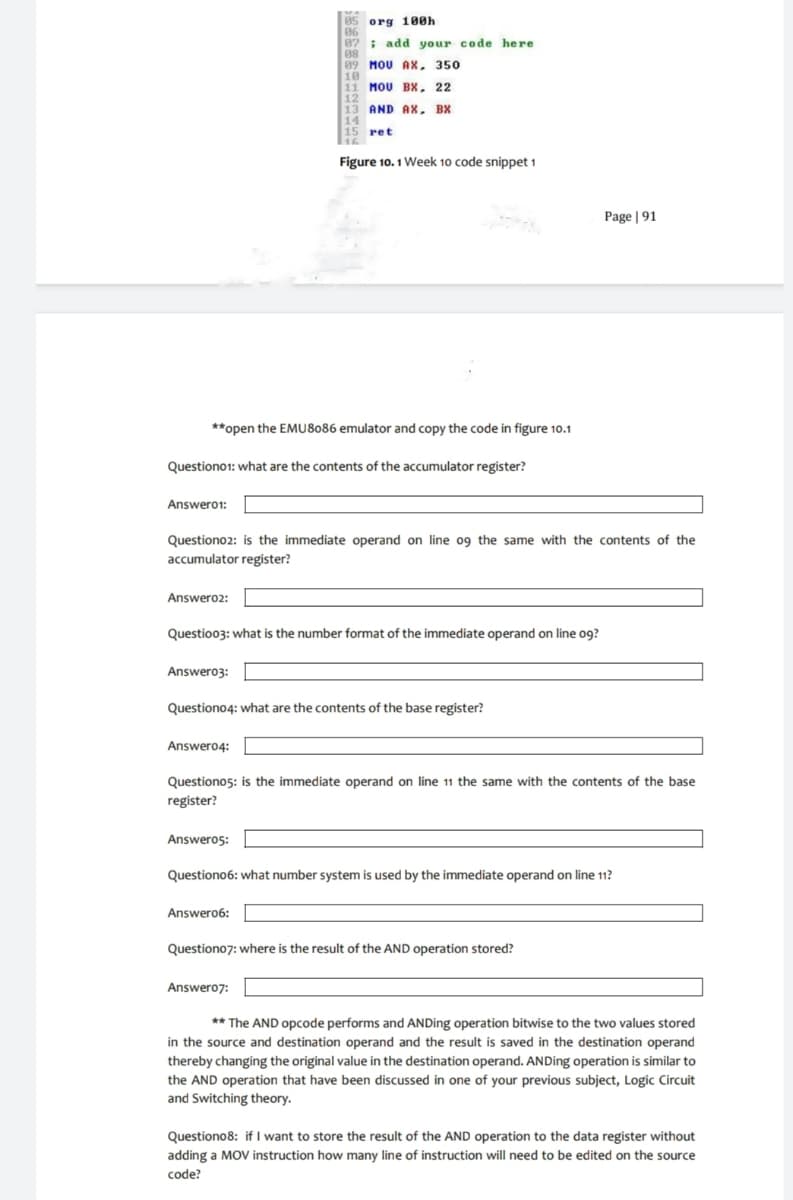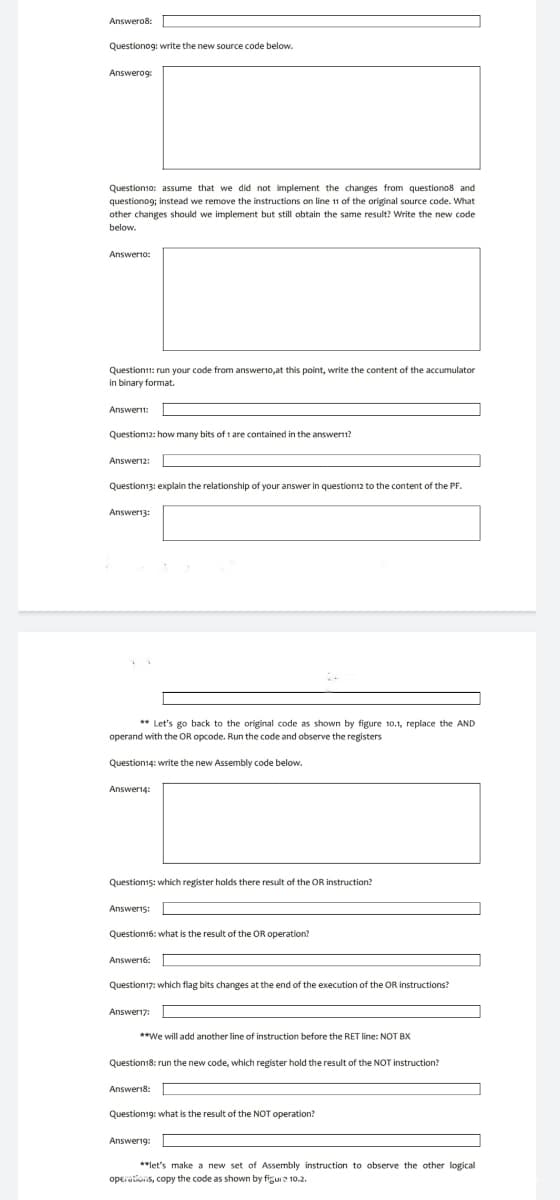85 org 100h 06 87 add your code here 08 89 MOU AX, 350 10 11 MOU BX, 22 12 13 AND AX, BX 14 15 ret 16 Figure 10.1 Week 10 code snippet 1 Page 91 **open the EMU 8086 emulator and copy the code in figure 10.1 Question01: what are the contents of the accumulator register? Answer01: Questiono2: is the immediate operand on line 09 the same with the contents of the accumulator register? Answero2: Questio03: what is the number format of the immediate operand on line 09? Answero3: Question04: what are the contents of the base register? Answer04: Question05: is the immediate operand on line 11 the same with the contents of the base register? Answero5: Question06: what number system is used by the immediate operand on line 11? Answero6: Question07: where is the result of the AND operation stored? Answer07: **The AND opcode performs and ANDing operation bitwise to the two values stored in the source and destination operand and the result is saved in the destination operand thereby changing the original value in the destination operand. ANDing operation is similar to the AND operation that have been discussed in one of your previous subject, Logic Circuit and Switching theory. Question08: if I want to store the result of the AND operation to the data register without adding a MOV instruction how many line of instruction will need to be edited on the source code? Answero8: Questionog: write the new source code below. Answerog: Question10: assume that we did not implement the changes from questiono8 and questionog; instead we remove the instructions on line 11 of the original source code. What other changes should we implement but still obtain the same result? Write the new code below. Answer10: Question11: run your code from answerto,at this point, write the content of the accumulator in binary format. Answer11: Question12: how many bits of 1 are contained in the answer? Answer12: Question13: explain the relationship of your answer in question12 to the content of the PF. Answer13: **Let's go back to the original code as shown by figure 10.1, replace the AND operand with the OR opcode. Run the code and observe the registers Question14: write the new Assembly code below. Answer14: Question15: which register holds there result of the OR instruction? Answer15: Question16: what is the result of the OR operation? Answer16: Question17: which flag bits changes at the end of the execution of the OR instructions? Answer17: **We will add another line of instruction before the RET line: NOT BX Question18: run the new code, which register hold the result of the NOT instruction? Answer18: Question19: what is the result of the NOT operation? Answer19: **let's make a new set of Assembly instruction to observe the other logical operations, copy the code as shown by figure 10.2.
85 org 100h 06 87 add your code here 08 89 MOU AX, 350 10 11 MOU BX, 22 12 13 AND AX, BX 14 15 ret 16 Figure 10.1 Week 10 code snippet 1 Page 91 **open the EMU 8086 emulator and copy the code in figure 10.1 Question01: what are the contents of the accumulator register? Answer01: Questiono2: is the immediate operand on line 09 the same with the contents of the accumulator register? Answero2: Questio03: what is the number format of the immediate operand on line 09? Answero3: Question04: what are the contents of the base register? Answer04: Question05: is the immediate operand on line 11 the same with the contents of the base register? Answero5: Question06: what number system is used by the immediate operand on line 11? Answero6: Question07: where is the result of the AND operation stored? Answer07: **The AND opcode performs and ANDing operation bitwise to the two values stored in the source and destination operand and the result is saved in the destination operand thereby changing the original value in the destination operand. ANDing operation is similar to the AND operation that have been discussed in one of your previous subject, Logic Circuit and Switching theory. Question08: if I want to store the result of the AND operation to the data register without adding a MOV instruction how many line of instruction will need to be edited on the source code? Answero8: Questionog: write the new source code below. Answerog: Question10: assume that we did not implement the changes from questiono8 and questionog; instead we remove the instructions on line 11 of the original source code. What other changes should we implement but still obtain the same result? Write the new code below. Answer10: Question11: run your code from answerto,at this point, write the content of the accumulator in binary format. Answer11: Question12: how many bits of 1 are contained in the answer? Answer12: Question13: explain the relationship of your answer in question12 to the content of the PF. Answer13: **Let's go back to the original code as shown by figure 10.1, replace the AND operand with the OR opcode. Run the code and observe the registers Question14: write the new Assembly code below. Answer14: Question15: which register holds there result of the OR instruction? Answer15: Question16: what is the result of the OR operation? Answer16: Question17: which flag bits changes at the end of the execution of the OR instructions? Answer17: **We will add another line of instruction before the RET line: NOT BX Question18: run the new code, which register hold the result of the NOT instruction? Answer18: Question19: what is the result of the NOT operation? Answer19: **let's make a new set of Assembly instruction to observe the other logical operations, copy the code as shown by figure 10.2.
Computer Networking: A Top-Down Approach (7th Edition)
7th Edition
ISBN:9780133594140
Author:James Kurose, Keith Ross
Publisher:James Kurose, Keith Ross
Chapter1: Computer Networks And The Internet
Section: Chapter Questions
Problem R1RQ: What is the difference between a host and an end system? List several different types of end...
Related questions
Question
Pls help.me answer the following, show neat and whole solution and kindly send a screenshot of simulation.

Transcribed Image Text:85 org 100h
06
87 add your code here
08
89 MOU AX, 350
10
11 MOU BX, 22
12
13 AND AX, BX
14
15 ret
16
Figure 10.1 Week 10 code snippet 1
Page 91
**open the EMU 8086 emulator and copy the code in figure 10.1
Question01: what are the contents of the accumulator register?
Answer01:
Questiono2: is the immediate operand on line 09 the same with the contents of the
accumulator register?
Answero2:
Questio03: what is the number format of the immediate operand on line 09?
Answero3:
Question04: what are the contents of the base register?
Answer04:
Question05: is the immediate operand on line 11 the same with the contents of the base
register?
Answero5:
Question06: what number system is used by the immediate operand on line 11?
Answero6:
Question07: where is the result of the AND operation stored?
Answer07:
**The AND opcode performs and ANDing operation bitwise to the two values stored
in the source and destination operand and the result is saved in the destination operand
thereby changing the original value in the destination operand. ANDing operation is similar to
the AND operation that have been discussed in one of your previous subject, Logic Circuit
and Switching theory.
Question08: if I want to store the result of the AND operation to the data register without
adding a MOV instruction how many line of instruction will need to be edited on the source
code?

Transcribed Image Text:Answero8:
Questionog: write the new source code below.
Answerog:
Question10: assume that we did not implement the changes from questiono8 and
questionog; instead we remove the instructions on line 11 of the original source code. What
other changes should we implement but still obtain the same result? Write the new code
below.
Answer10:
Question11: run your code from answerto,at this point, write the content of the accumulator
in binary format.
Answer11:
Question12: how many bits of 1 are contained in the answer?
Answer12:
Question13: explain the relationship of your answer in question12 to the content of the PF.
Answer13:
**Let's go back to the original code as shown by figure 10.1, replace the AND
operand with the OR opcode. Run the code and observe the registers
Question14: write the new Assembly code below.
Answer14:
Question15: which register holds there result of the OR instruction?
Answer15:
Question16: what is the result of the OR operation?
Answer16:
Question17: which flag bits changes at the end of the execution of the OR instructions?
Answer17:
**We will add another line of instruction before the RET line: NOT BX
Question18: run the new code, which register hold the result of the NOT instruction?
Answer18:
Question19: what is the result of the NOT operation?
Answer19:
**let's make a new set of Assembly instruction to observe the other logical
operations, copy the code as shown by figure 10.2.
Expert Solution
This question has been solved!
Explore an expertly crafted, step-by-step solution for a thorough understanding of key concepts.
Step by step
Solved in 2 steps

Recommended textbooks for you

Computer Networking: A Top-Down Approach (7th Edi…
Computer Engineering
ISBN:
9780133594140
Author:
James Kurose, Keith Ross
Publisher:
PEARSON

Computer Organization and Design MIPS Edition, Fi…
Computer Engineering
ISBN:
9780124077263
Author:
David A. Patterson, John L. Hennessy
Publisher:
Elsevier Science

Network+ Guide to Networks (MindTap Course List)
Computer Engineering
ISBN:
9781337569330
Author:
Jill West, Tamara Dean, Jean Andrews
Publisher:
Cengage Learning

Computer Networking: A Top-Down Approach (7th Edi…
Computer Engineering
ISBN:
9780133594140
Author:
James Kurose, Keith Ross
Publisher:
PEARSON

Computer Organization and Design MIPS Edition, Fi…
Computer Engineering
ISBN:
9780124077263
Author:
David A. Patterson, John L. Hennessy
Publisher:
Elsevier Science

Network+ Guide to Networks (MindTap Course List)
Computer Engineering
ISBN:
9781337569330
Author:
Jill West, Tamara Dean, Jean Andrews
Publisher:
Cengage Learning

Concepts of Database Management
Computer Engineering
ISBN:
9781337093422
Author:
Joy L. Starks, Philip J. Pratt, Mary Z. Last
Publisher:
Cengage Learning

Prelude to Programming
Computer Engineering
ISBN:
9780133750423
Author:
VENIT, Stewart
Publisher:
Pearson Education

Sc Business Data Communications and Networking, T…
Computer Engineering
ISBN:
9781119368830
Author:
FITZGERALD
Publisher:
WILEY